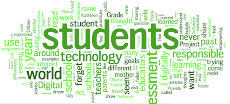At an assembly at the beginning of the year our staff was able to facilitate this innate sense of rule following to an understanding of what it is to be a school citizen. Through a series of activities, big buddies worked with little buddies on converting perceived rules into beliefs. For example, no running, no hitting, no pushing was transformed into "At our school we believe in SAFETY". This process taken from the book "Creating the Conditions" by Diane Gossen proved to be a vital step in changing the conversation. Instead of "Jonny stop running" the conversation becomes "Jonny can you tell me what we believe in at our school?" Since Jonny was part of coming up with the school belief of SAFETY he is able to self correct and begin to internalize appropriate hallway behaviour.
At our school the students were able to boil it down to 6 core beliefs. They include the following:
At our school we believe in Responsibility, Healthy Living, Inclusion, Honesty, Safety and Respect Y.O.E. (yourself, others & the environment). Interestingly, this list was extremely similar to lists that other schools that have gone through this process have come up with.
 Next we learned about inukshuks. Simply put inukshuks are Inuit stone statues that are meant to serve as guiding posts. We took our 6 beliefs and cut out big paper stones. On each stone we wrote one of the beliefs. Then we created a giant 2 dimensional inukshuk on the back wall of our stage. Surrounding each of the belief words on the stones the students then listed what that belief looked like, sounded like and felt like. The whole process served as an excellent vehicle for creating a common language of social responsibility and for empowering student ownership of student behaviour.
Next we learned about inukshuks. Simply put inukshuks are Inuit stone statues that are meant to serve as guiding posts. We took our 6 beliefs and cut out big paper stones. On each stone we wrote one of the beliefs. Then we created a giant 2 dimensional inukshuk on the back wall of our stage. Surrounding each of the belief words on the stones the students then listed what that belief looked like, sounded like and felt like. The whole process served as an excellent vehicle for creating a common language of social responsibility and for empowering student ownership of student behaviour.This school-wide "social contract" has been in place for just over a month. Student know that when they find themselves in the office, the conversation will be about our beliefs and about the student finding a way to repair their mistake through problem solving. Students who make mistakes are seen as providers of learning opportunities and if all involved learn from the mistake the students return to the community strengthened by their new knowledge.
The jump to the virtual world is an easy one. Our beliefs transcend firewalls, routers and servers. Rather than depend on filters, blocked popups and lock down procedures. We help our students understand that being digitally responsible citizens is no different than being responsible school citizens. Along with teaching students about internet safety, students are expected to behave in a manner that adheres to our school beliefs. When a student makes a mistake around internet behaviour, we treat it the same as if the student made a mistake in the real world. We help that student repair any damage done and we empower the student to meet the need saught by the misguided behaviour in another way.
The conversation now revolves around understanding our needs. Because all behaviour has purpose and the purpose is to meet one of the following needs: Fun, Belonging, Mastery, Freedom, Survival. The virtual world is yet another avenue for students to meet these needs. It is important that we help students meet these needs in the virtual world just like we help students meet these needs in the real world. Once you give the students ownership of their behaviour and you give them the vocabulary to articulate their needs the "discipline" conversation changes.
Some of my colleagues don't trust this process, what do you think?
Photo credit: Dave MacLean - Still Water Inukshuk - Powell River BC Canada








No comments:
Post a Comment